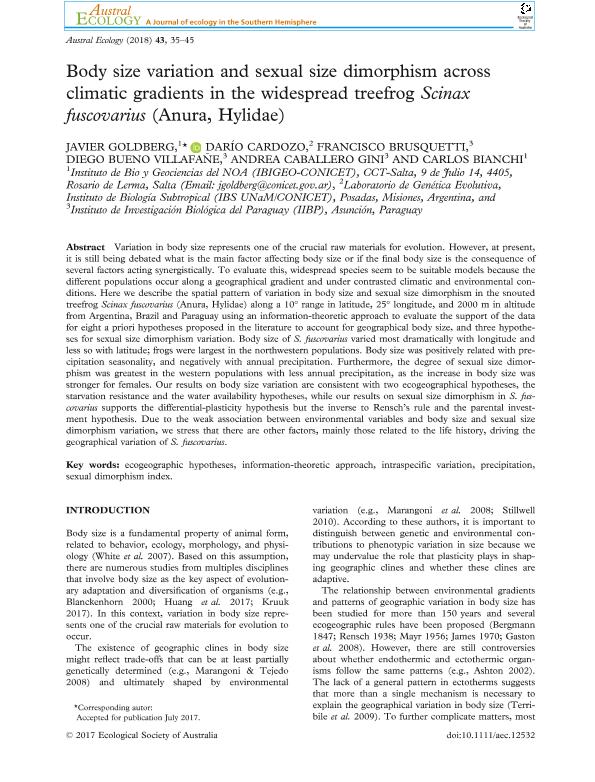Mostrar el registro sencillo del ítem
dc.contributor.author
Goldberg, Francisco Javier

dc.contributor.author
Cardozo, Dario Elbio

dc.contributor.author
Brusquetti, Francisco

dc.contributor.author
Bueno Villafañe, Diego

dc.contributor.author
Caballero Gini, Andrea Natalia

dc.contributor.author
Bianchi, Carlos Luis

dc.date.available
2019-12-06T15:06:11Z
dc.date.issued
2018-02
dc.identifier.citation
Goldberg, Francisco Javier; Cardozo, Dario Elbio; Brusquetti, Francisco; Bueno Villafañe, Diego; Caballero Gini, Andrea Natalia; et al.; Body size variation and sexual size dimorphism across climatic gradients in the widespread treefrog Scinax fuscovarius (Anura, Hylidae); Wiley Blackwell Publishing, Inc; Austral Ecology; 43; 1; 2-2018; 35-45
dc.identifier.issn
1442-9985
dc.identifier.uri
http://hdl.handle.net/11336/91609
dc.description.abstract
Variation in body size represents one of the crucial raw materials for evolution. However, at present, it is still being debated what is the main factor affecting body size or if the final body size is the consequence of several factors acting synergistically. To evaluate this, widespread species seem to be suitable models because the different populations occur along a geographical gradient and under contrasted climatic and environmental conditions. Here we describe the spatial pattern of variation in body size and sexual size dimorphism in the snouted treefrog Scinax fuscovarius (Anura, Hylidae) along a 10° range in latitude, 25° longitude, and 2000 m in altitude from Argentina, Brazil and Paraguay using an information-theoretic approach to evaluate the support of the data for eight a priori hypotheses proposed in the literature to account for geographical body size, and three hypotheses for sexual size dimorphism variation. Body size of S. fuscovarius varied most dramatically with longitude and less so with latitude; frogs were largest in the northwestern populations. Body size was positively related with precipitation seasonality, and negatively with annual precipitation. Furthermore, the degree of sexual size dimorphism was greatest in the western populations with less annual precipitation, as the increase in body size was stronger for females. Our results on body size variation are consistent with two ecogeographical hypotheses, the starvation resistance and the water availability hypotheses, while our results on sexual size dimorphism in S. fuscovarius supports the differential-plasticity hypothesis but the inverse to Rensch's rule and the parental investment hypothesis. Due to the weak association between environmental variables and body size and sexual size dimorphism variation, we stress that there are other factors, mainly those related to the life history, driving the geographical variation of S. fuscovarius.
dc.format
application/pdf
dc.language.iso
eng
dc.publisher
Wiley Blackwell Publishing, Inc

dc.rights
info:eu-repo/semantics/openAccess
dc.rights.uri
https://creativecommons.org/licenses/by-nc-sa/2.5/ar/
dc.subject
ECOGEOGRAPHIC HYPOTHESES
dc.subject
INFORMATION-THEORETIC APPROACH
dc.subject
INTRASPECIFIC VARIATION
dc.subject
PRECIPITATION
dc.subject
SEXUAL DIMORPHISM INDEX
dc.subject.classification
Biología

dc.subject.classification
Ciencias Biológicas

dc.subject.classification
CIENCIAS NATURALES Y EXACTAS

dc.title
Body size variation and sexual size dimorphism across climatic gradients in the widespread treefrog Scinax fuscovarius (Anura, Hylidae)
dc.type
info:eu-repo/semantics/article
dc.type
info:ar-repo/semantics/artículo
dc.type
info:eu-repo/semantics/publishedVersion
dc.date.updated
2019-10-22T17:24:37Z
dc.journal.volume
43
dc.journal.number
1
dc.journal.pagination
35-45
dc.journal.pais
Reino Unido

dc.journal.ciudad
Londres
dc.description.fil
Fil: Goldberg, Francisco Javier. Consejo Nacional de Investigaciones Científicas y Técnicas. Centro Científico Tecnológico Conicet - Salta. Instituto de Bio y Geociencias del NOA. Universidad Nacional de Salta. Facultad de Ciencias Naturales. Museo de Ciencias Naturales. Instituto de Bio y Geociencias del NOA; Argentina
dc.description.fil
Fil: Cardozo, Dario Elbio. Consejo Nacional de Investigaciones Científicas y Técnicas. Centro Científico Tecnológico Conicet - Nordeste. Instituto de Biología Subtropical. Instituto de Biología Subtropical - Nodo Posadas | Universidad Nacional de Misiones. Instituto de Biología Subtropical. Instituto de Biología Subtropical - Nodo Posadas; Argentina
dc.description.fil
Fil: Brusquetti, Francisco. Instituto de Investigaci on Biol ogica del Paraguay; Paraguay
dc.description.fil
Fil: Bueno Villafañe, Diego. Instituto de Investigaci on Biol ogica del Paraguay; Paraguay
dc.description.fil
Fil: Caballero Gini, Andrea Natalia. Instituto de Investigaci on Biol ogica del Paraguay; Paraguay. Consejo Nacional de Investigaciones Científicas y Técnicas; Argentina
dc.description.fil
Fil: Bianchi, Carlos Luis. Consejo Nacional de Investigaciones Científicas y Técnicas. Centro Científico Tecnológico Conicet - Salta. Instituto de Bio y Geociencias del NOA. Universidad Nacional de Salta. Facultad de Ciencias Naturales. Museo de Ciencias Naturales. Instituto de Bio y Geociencias del NOA; Argentina
dc.journal.title
Austral Ecology

dc.relation.alternativeid
info:eu-repo/semantics/altIdentifier/doi/http://dx.doi.org/10.1111/aec.12532
dc.relation.alternativeid
info:eu-repo/semantics/altIdentifier/url/https://onlinelibrary.wiley.com/doi/full/10.1111/aec.12532
Archivos asociados
